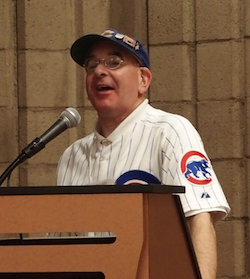

By Howard M. Wasserman
on Nov 19, 2018 at 2:59 pm


The Roberts Court has shown two jurisprudential preferences. One is for protecting the freedom of speech, earning it a reputation as perhaps the most speech-protective Supreme Court in history. The other is for protecting law-enforcement discretion and power, especially against private suits for damages under 42 U.S.C. § 1983, earning criticisms from some who argue that the court over-protects police officers who violate the Constitution.
Those instincts collide in Nieves v. Bartlett, to be argued on November 26.
At issue is whether a plaintiff pursuing a First Amendment claim arising from an allegedly retaliatory arrest must show that the officer lacked probable cause to arrest the plaintiff on any charge. The Supreme Court had an opportunity to address that issue last term in Lozman v. City of Riviera Beach, but the arrest there was alleged to have resulted from a municipal policy of retaliation, rather than the on-the-spot discretionary decision of an individual officer. The question the Supreme Court avoided in Lozman is squarely presented in Nieves. The case began when two Alaska state troopers, Luis Nieves and Bryce Weight, arrested Russell Bartlett, an allegedly intoxicated and belligerent participant in the state’s Arctic Man Festival. Bartlett was charged with disorderly conduct and resisting arrest. After the charges were dismissed, he sued the officers under Section 1983, alleging that they arrested him in retaliation for his refusal to speak to them and for his challenge to their attempt to question a teenager outside the presence of the youth’s parent or guardian.
The parties, and the United States as amicus curiae in support of the officers, disagree on several aspects of the case.
Text of 42 U.S.C. § 1983
Bartlett begins with the text of Section 1983, which provides a cause of action, including for damages, against “every person” acting “under color” of state law who “subjects” a person to “the deprivation of any right” secured by the Constitution. That text is satisfied here, Bartlett argues, and there is no textual or policy basis for adding an additional element to the cause of action for some First Amendment claims.
The United States maintains that a plaintiff either must prove the absence of probable cause or show that he was arrested pursuant to an official policy of retaliation against protected speech. Bartlett responds that any “policy” element in Section 1983 applies only to claims for municipal liability. Imposing that as an additional requirement in a claim against an individual “in essence proposes a construction of Section 1983 under which only municipalities would be liable for a category of First Amendment violations.” Extending “persons” under Section 1983 to include government entities does not support narrowing the term to exclude natural persons, unless those persons enjoy absolute immunity (such as legislators or prosecutors), which police officers do not.
The United States argues that the Supreme Court has rejected the view that a private action for damages must be available for every violation of every right. It points to recent decisions narrowing the judicially created damages action against federal officials, in which the court has held that “in most instances” a private remedy is unjustified. It also points to Section 1983 cases imposing practical limitations on available damages, such as when a plaintiff cannot show a compensable injury.
Effect of Hartman v. Moore and retaliatory prosecution
In Hartman v. Moore, the Supreme Court held that a plaintiff pursuing a First Amendment retaliatory prosecution claim must plead and prove that the defendant lacked probable cause to bring the criminal charges. The court has twice considered, but failed to resolve, whether that requirement extends to retaliatory arrests. In Reichle v. Howards, the court declined to address the requirements for a First Amendment retaliatory-arrest claim, concluding that at the time of the arrest, it was not clearly established that a retaliatory arrest violated the First Amendment, thus the officers were entitled to qualified immunity. In Lozman, the court held that the allegations of a retaliatory municipal policy presented in that case warranted a different standard.
The officers argue that Hartman required lack of probable cause as a formal element because of the complexity of determining causation and the “powerful evidentiary significance” of probable cause in that determination. Both features are present in retaliatory arrests, which justifies extending Hartman from retaliatory prosecutions to claims challenging the “mine run of arrests made by police officers.” Retaliatory arrests often involve multiple officers, creating complex questions of whose animus played what role in the arrest. In this case, one officer was allegedly motivated by Bartlett’s refusal to speak with officers, while the other was allegedly motivated by Bartlett’s challenge to the officers’ authority to question an unaccompanied minor. Officers also must make split-second determinations in tense, uncertain and rapidly evolving situations. And a person’s speech may be a legitimate factor in an officer’s decision to arrest — expressions of hostility or uncooperativeness and expressive challenges to police authority, combined with conduct, may lead an officer to believe the arrestee poses an immediate threat, poses a danger to the public or intends to persist in unlawful conduct. An objective standard such as probable cause allows officers to act decisively without fear of a difficult-to-defend lawsuit.
The United States echoes these arguments about the similarities between retaliatory prosecution and retaliatory arrest, as well as the distinctions between police decisions and other decisions (such as employment and policy choices) in which public officials have more time for deliberation before they act. Because the presence or absence of probable cause to bring criminal charges provides valuable circumstantial evidence for causation, it makes sense to require the plaintiff to plead and prove it as an element, rather than allowing the plaintiff to simply allege a difficult-to-prove fact such as state of mind. Finally, similar “objective screens” are required for constitutional claims other than First Amendment retaliatory prosecution. Lack of probable cause is an element of Fourth Amendment claims and differential treatment of similarly situated people is an element of equal-protection claims. If Bartlett prevails, the United States insists, retaliatory arrest would be carved out as the lone claim that does not require some objective showing.
Bartlett offers a different read on Hartman. The Supreme Court imposed the absence-of-probable-cause element to protect absolute prosecutorial immunity; if the plaintiff can show lack of probable cause by the officers, he can pursue a claim against them without interfering with prosecutorial decision-making. But retaliatory arrest does not require protection for independent prosecutorial decision-making, because the claim focuses on the actions and intent of the arresting officers. Bartlett emphasizes two concerns. One is “catch-and-release arrests,” in which officers arrest some people but not others simultaneously engaged in the same conduct, when the distinguishing factor is that the arrestees engaged in constitutionally protected speech and those not arrested did not; the goal seems to be to remove one group from a public situation, although the arrestees are virtually never prosecuted. A second concern is that proving absence of probable cause, although perhaps cost-free for retaliatory prosecution, is not cost-free for retaliatory arrest. For retaliatory prosecution, the plaintiff need only show lack of probable cause for the crimes charged. For retaliatory arrest, the plaintiff must show an absence of probable cause to arrest for any offense the officers may subsequently find, beyond the one in the officer’s mind, on an arrest report or in an initial charging document.
Bartlett argues that there should be no distinction between claims for First Amendment retaliatory-arrest and claims of racially retaliatory arrests under the 14th Amendment, which do not require lack of probable cause. If Martin Luther King Jr. had brought a Section 1983 claim stemming from his arrest for driving five miles above the speed limit near Montgomery, Alabama, “it should not have mattered whether he had had alleged that he was arrested because he was African American or due to his advocacy of racial equality.”
Common law analogues
Courts define the contours and requirements of the Section 1983 cause of action through common law analogues. When Congress enacted Section 1983 as part of the Ku Klux Klan Act of 1871, there was no common law tort of malicious prosecution. But the officers identify three analogous torts: malicious prosecution, malicious arrest and false imprisonment. At common law, a showing of probable cause defeated the first two claims and “a great majority of states and authorities” held that probable cause also defeated the third. The United States agrees that the first and third are appropriate analogues for requiring a showing of absence of probable cause. The United States goes one step further — a claim fails on a showing of probable cause to arrest on any offense, even if the officer did not specify that offense at the time of the arrest. Police officers are trained to identify a course of conduct justifying arrest, not to master the elements of specific offenses.
Bartlett argues that common law should not play the same role in First Amendment claims, because the purpose of the First Amendment is to protect criticisms that undermine respect for government. The First Amendment “is not directed at arrests; rather, it condemns the use of government powers to inflict any form of official reprisal for protected expression.” If the court does look for an analogue, the closest is false arrest/false imprisonment, which was not defeated by the existence of probable cause alone, especially for misdemeanor arrests.
Effect on the freedom of speech
The parties differ over how much a no-probable-cause requirement would undermine First Amendment values.
The officers argue that a damages remedy is less necessary in the case of an “‘ad hoc, on-the-spot decision by an individual officer’” than in cases involving government policies that infringe on speech. Official government policies taking sides against unpopular ideas or information, not an individual police officer’s individual arrest decision, implicate the First Amendment’s “core concern.” Government policy is a more potent form of retaliation, thereby creating a compelling need for redress via civil damages. Challenges to officers’ authority and personal insults are not “speech on matters of public concern that ‘occupies the highest rung of the hierarchy of First Amendment values.’” Nor does challenging or insulting police officers constitute a petition for redress of grievances entitled to similarly heightened protection.
The officers also argue that there are other ways to deter retaliatory arrests, including investigation and discipline of individual officers. Internal self-regulation has become more likely with the proliferation of smartphones and recording, which incentivizes law-enforcement agencies to address complaints and demonstrate accountability. Government failure to take such steps to resolve a “pervasive” problem may give rise to a suit against the municipality for maintaining a policy of allowing retaliatory policing. The United States emphasizes its unique role in providing “an important backstop for safeguarding constitutional rights,” by prosecuting individual officers for willful First Amendment violations and pursuing injunctive remedies against state and local law-enforcement agencies to remedy a pattern or practice of retaliatory policing.
Bartlett counters that the “freedom of individuals verbally to oppose or challenge police action” is “one of the principal characteristics by which we distinguish a free nation from a police state,” placing it high in the hierarchy of First Amendment values. And alternative remedies are insufficient. Besides not providing a direct remedy to the injured person, the Department of Justice has not prosecuted any officer for retaliatory arrest, although retaliatory policing has been found in many civil actions against unconstitutional departmental policies and practices. Similarly, state-law remedies for police misconduct should not undermine the availability of a Section 1983 damages claim for a violation of federal law.
This is a sneakily significant case, with supporters of the competing jurisprudential instincts lining up as amici curiae on opposite sides. The District of Columbia and a local-government advocacy group support the officers; numerous First Amendment, press and constitutional-rights organizations support Bartlett, as well as Fane Lozman, the plaintiff in last term’s retaliatory-arrest case.